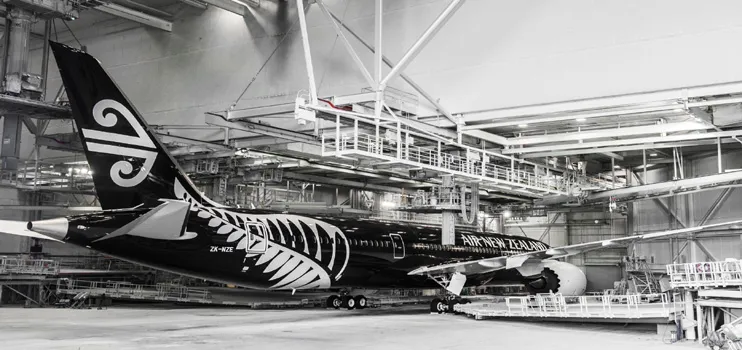
Boeing 787-9 certified
Jun 16, 2014

The Boeing 787-9 is a state-of-the-art, long-haul, wide-body aircraft that is part of the Dreamliner family. Certified for commercial flight, it features advanced aerodynamics and lightweight composite materials, enhancing fuel efficiency and reducing operational costs. With a seating capacity typically ranging from 240 to 290 passengers, it offers a spacious and comfortable cabin, equipped with modern amenities. The aircraft is powered by two high-bypass turbofan engines, providing impressive range and performance. Its innovative technology and design contribute to a quieter, more environmentally friendly flying experience, making it a popular choice for airlines worldwide.
The Boeing 787-9 has made significant strides in the aviation industry, receiving various certifications that highlight its efficiency and advanced technology. This aircraft model is part of Boeing's Dreamliner family and is known for its fuel efficiency, passenger comfort, and cutting-edge design. Let's explore the key features that have led to its certification and popularity among airlines worldwide.
Key Features of the Boeing 787-9
The Boeing 787-9 is built with several innovative features that contribute to its certification. Here are some of the most significant aspects:
| Feature | Description |
|---|---|
| Fuel Efficiency | The 787-9 uses advanced aerodynamics and lightweight materials, resulting in a 20% improvement in fuel efficiency compared to older aircraft models. |
| Passenger Comfort | With larger windows, improved cabin pressure, and quieter engines, the 787-9 provides a more comfortable flying experience for passengers. |
| Advanced Technology | Equipped with state-of-the-art avionics and systems, the 787-9 enhances safety and operational efficiency, contributing to its certification. |
| Environmental Sustainability | The use of composite materials and efficient engines helps reduce carbon emissions, making the 787-9 a more eco-friendly option for airlines. |
Certification Process of the Boeing 787-9
The certification process for the Boeing 787-9 is rigorous and involves multiple stages, ensuring that the aircraft meets the highest safety and performance standards. The key steps in the certification process include:
- Design and Development: Boeing engineers design the aircraft to meet various regulatory requirements and undergo extensive testing.
- Flight Testing: The 787-9 undergoes multiple test flights to evaluate its performance, safety, and operational capabilities.
- Regulatory Approval: The aircraft must receive approval from aviation authorities such as the Federal Aviation Administration (FAA) and the European Union Aviation Safety Agency (EASA).
- Ongoing Compliance: After certification, Boeing continues to monitor the performance and safety of the 787-9, ensuring it adheres to all regulatory standards.
Advantages of the Boeing 787-9 Certification
The certification of the Boeing 787-9 comes with numerous advantages for airlines and passengers alike:
| Advantage | Description |
|---|---|
| Market Acceptance | Certification boosts the credibility of the aircraft, making it more appealing to airlines looking to expand their fleets. |
| Operational Flexibility | The 787-9's range and efficiency allow airlines to operate on various routes, from short-haul to long-haul flights. |
| Enhanced Passenger Experience | Airlines can offer a more comfortable and enjoyable flight experience, leading to higher customer satisfaction and loyalty. |
| Fuel Cost Savings | The improved fuel efficiency translates to significant cost savings for airlines, allowing for more competitive pricing. |
Impact on the Aviation Industry
The Boeing 787-9's certification has greatly impacted the aviation industry by setting new standards for performance and efficiency. As airlines embrace this technology, it encourages competition and innovation within the sector. Some of the notable impacts include:
- Pushing Manufacturers to Innovate: Competitors are compelled to develop more advanced aircraft to keep up with the performance of the 787-9.
- Shifting Market Dynamics: With its fuel efficiency and operational capabilities, the 787-9 has altered route planning and airline strategies globally.
- Encouraging Environmental Responsibility: The focus on reducing emissions has prompted airlines and manufacturers to prioritize sustainability in their operations and designs.
Conclusion
The certification of the Boeing 787-9 is a testament to its innovative design, fuel efficiency, and commitment to passenger comfort. As airlines continue to adopt this aircraft, the aviation industry is witnessing a shift toward more sustainable and efficient travel solutions. The 787-9 not only enhances operational capabilities for airlines but also improves the overall flying experience for passengers. Its impact on the market is profound, paving the way for future advancements in aviation technology.
In summary, the Boeing 787-9 is a game-changer in the aviation sector, setting a benchmark for future aircraft with its certified features and advantages. With ongoing developments, the future of air travel looks promising, and the 787-9 is at the forefront of this evolution.
Related Articles

Explore Thailand: The Best Islands to Visit for Paradise, Adventure, and Relaxation

The Ultimate Guide to the Best Islands in Thailand for Your Next Getaway

Do babies need passports? How to get a passport for a newborn

How to get a U.S. passport fast: here’s how to expedite the process

What is Mobile Passport Control: 5 reasons why you should use it

SENTRI vs. Global Entry: A detailed guide

Do you need a passport to go to the Bahamas? Let’s find out

Do you need a passport to go to Mexico? A detailed guide

Do you need a passport to go to Canada? We got the answer

Do You Need a Passport for a Cruise: An Essential Travel Guide

Booster Seat Requirements: All the Rules to Follow in Your Rental Car

What Are the World’s Most Powerful Passports, and How Does Yours Rank?

How to Take a Passport Photo at Home: A Helpful Guide

You've got to have heart! Southwest's new livery

Your opinion: Should water be free on low cost carriers?

Young women bolder than guys as solo travellers
